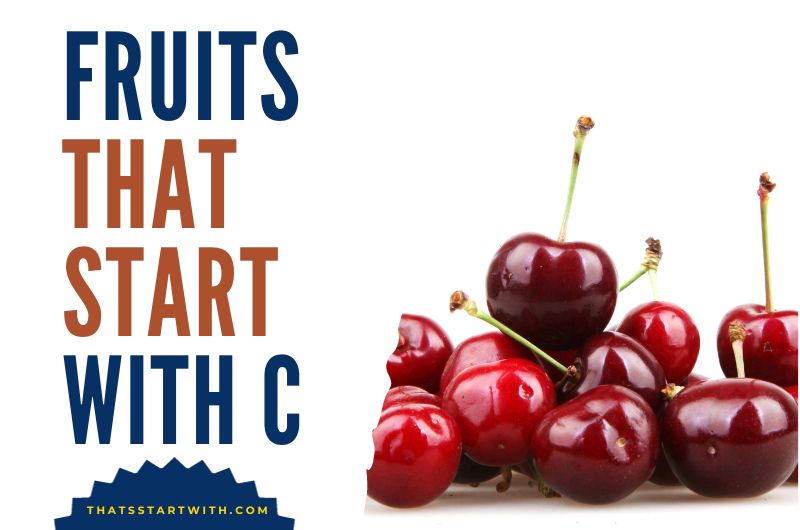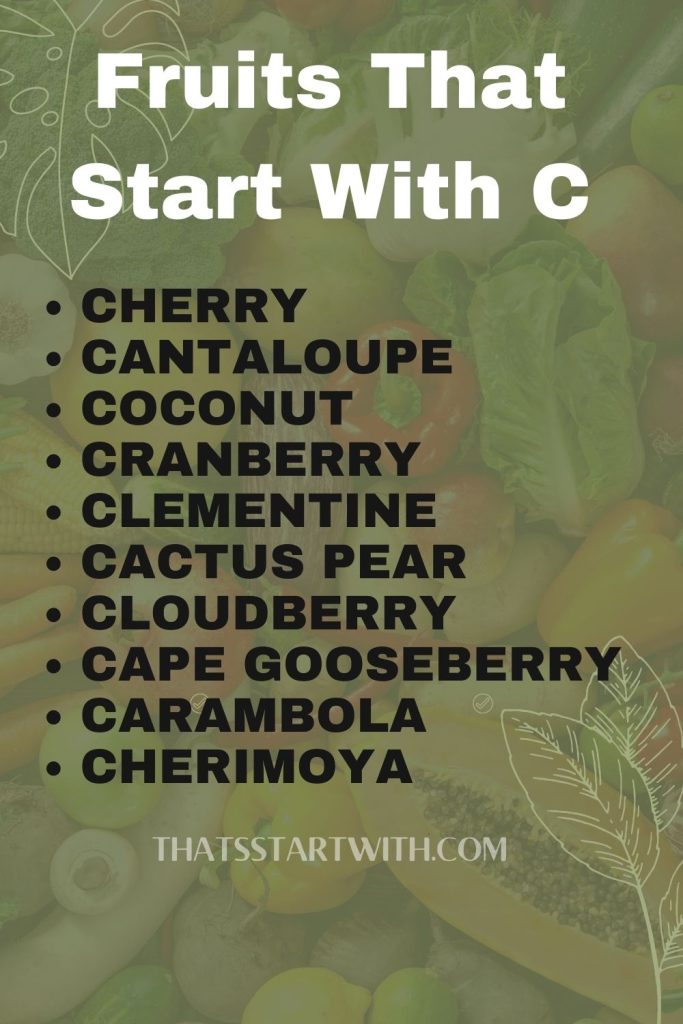
Fruits are nature’s sweet and nutritious gifts, offering a diverse array of flavors, textures, and health benefits. Exploring the world of fruits opens up a fascinating journey through orchards and tropical landscapes, revealing a rich variety of options that cater to different palates. Among this vast assortment, there is a distinct group of fruits that share a commonality they all begin with the letter “C.”
This curated collection of fruits that start with C showcases a delightful mix of tastes, colors, and nutritional profiles. From the familiar and widely enjoyed to the exotic and lesser-known, these fruits contribute to a balanced and vibrant diet.
Whether you’re a culinary enthusiast, a health-conscious individual, or simply curious about the wonders of nature, delving into the realm of fruits that start with C promises an exploration filled with freshness and flavor.
Join us as we embark on a journey to discover and appreciate the diverse and delectable world of fruits beginning with the letter C.
Fruits That Start With C

Cherry:
Cherries are small, vibrant red or yellow fruits known for their sweet and tart flavor. Whether enjoyed fresh, dried, or as part of various culinary creations, cherries are a delightful addition to any menu.
Cantaloupe:
This succulent and juicy melon is a refreshing treat during the warmer months. With its orange flesh and sweet aroma, cantaloupe is a popular choice for snacks, salads, and smoothies.
Coconut:
The coconut, with its versatile use in both savory and sweet dishes, is a tropical delight. From coconut water to coconut milk and shredded coconut, this fruit offers a rich and distinct flavor.
Cranberry:
Known for their vibrant red color and tart taste, cranberries are often associated with Thanksgiving. These berries are not only delicious but also packed with antioxidants and health benefits.
Clementine:
A small and easy-to-peel citrus fruit, clementines are a favorite for snacking. Their sweet and tangy flavor makes them a popular choice for both kids and adults.
Cucumber:
While commonly thought of as a vegetable, cucumbers are technically a fruit. With their mild taste and high water content, cucumbers are versatile additions to salads, sandwiches, and refreshing beverages.
Cactus Pear:
Also known as prickly pear, this fruit comes from cactus plants and has a vibrant, magenta-colored flesh. Despite its spiky exterior, cactus pear offers a subtly sweet and mildly tangy taste.
Chayote:
Chayote is a green, wrinkled fruit with a crisp texture. Commonly used in salads, stir-fries, and soups, chayote has a mild flavor that complements a variety of dishes.
Cloudberry:
Found in colder regions, cloudberry is a unique fruit with a golden color. Often used in jams and desserts, it has a sweet and slightly tart taste.
Custard Apple:
Also known as sugar apple or cherimoya, the custard apple has a creamy, custard-like texture and a sweet, tropical flavor. It’s a popular choice in desserts and smoothies.
Crabapple:
Resembling miniature apples, crabapples have a tart taste. While less commonly eaten fresh, they are often used in jams, jellies, and culinary preparations.
Currant:
Currants are small, berry-like fruits that come in red, black, or white varieties. They are prized for their intense flavor and are used in jams, sauces, and desserts.
Chinese Gooseberry (Kiwi):
Originally known as Chinese gooseberry, the kiwi is a small, fuzzy fruit with vibrant green flesh. It is famous for its unique sweet and tangy taste and is rich in vitamin C.
Cape Gooseberry:
Encased in a papery husk, the cape gooseberry is a small, golden fruit with a sweet and tart flavor. It is often used in jams, desserts, and as a decorative garnish.
Citron:
Citron is a large, lemon-like fruit with a thick rind and a mild, fragrant pulp. It is primarily used for its aromatic peel in cooking and baking.
Carambola (Star Fruit):
Shaped like a star when sliced, carambola, or star fruit, has a sweet and slightly tangy taste. It’s often enjoyed fresh or as a decorative element in salads and desserts.
Cherimoya:
Cherimoya, also known as the custard apple, has a creamy texture and a sweet, tropical flavor. It’s often eaten fresh or used in smoothies and desserts.
Cupuacu:
Native to the Amazon rainforest, cupuacu is a large, brown fruit with white pulp. It has a unique combination of chocolate and pineapple flavors, making it a prized ingredient in desserts.
Ceylon Gooseberry (Ketembilla):
Commonly found in Sri Lanka, ketembilla is a small, purple fruit with a sweet and slightly tangy taste. It is often eaten fresh or used in jams.
Cassava (Yuca):
While primarily known for its starchy root, cassava also produces a sweet, tuberous fruit. In some cultures, cassava fruit is used in culinary preparations and beverages.
Related Articles:
Conclusion
The exploration of fruits that start with C unveils a vibrant assortment that not only tantalizes the taste buds but also enriches culinary experiences. From the familiar sweetness of cherries and cantaloupes to the exotic flavors of custard apples and cactus pears, this collection showcases the diversity nature offers within a single letter of the alphabet.
These fruits bring not only unique tastes but also a spectrum of nutritional benefits, contributing to a well-rounded and healthy diet.
Whether enjoyed fresh, incorporated into savory dishes, or used as key ingredients in desserts, fruits that start with C bring a refreshing and wholesome dimension to meals.
Greetings, I’m Andrew Miller, and I’ve initiated this blog to assist individuals in discovering a wide range of things alphabetically, from A to Z.